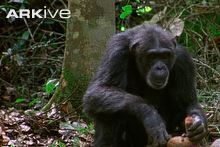Rank Subspecies | Phylum Chordata Genus Pan | |
 | ||
Similar Eastern chimpanzee, Central chimpanzee, Nigeria‑Cameroon chimpanzee, Common chimpanzee, Western red colobus | ||
Western chimpanzee
The western chimpanzee, or West African chimpanzee, (Pan troglodytes verus) is a subspecies of the common chimpanzee. It inhabits western Africa, mainly in Côte d'Ivoire and Guinea but with populations in surrounding countries.
Contents
- Western chimpanzee
- Etymology
- Classification
- Conservation status
- Distribution and habitat
- Diet and hunting
- Unique behavior
- References
Etymology
Pan is derived from the Greek god of fields, groves, and wooded glens, Pan. Troglodytes is Greek for 'cave-dweller', and was coined by Johann Friedrich Blumenbach in his Handbuch der Naturgeschichte (Handbook of Natural History) published in 1779. Verus is Latin for 'true', and was given to this subspecies in 1934 by Ernst Schwarz. Originally Schwarz classified it as Pan satyrus verus.
Classification
The western chimpanzee is a subspecies of the common chimpanzee (Pan troglodytes), along with the central chimpanzee (P. t. troglodytes), the Nigeria-Cameroon chimpanzee (P. t. ellioti), and the eastern chimpanzee (P. t. schweinfurthii). They became genetically different from other chimpanzee subspecies approximately 500,000 years ago.
Conservation status
The IUCN lists the western chimpanzee as a critically endangered species on their Red List of Threatened Species. There are an estimated 21,300 to 55,600 individuals in the wild. The primary threat to the western chimpanzee is habitat loss, although it is also killed for bushmeat.
Distribution and habitat
The population of the western chimpanzee once spanned from southern Senegal all the way east to the Niger River. Today, the largest populations are found in Côte d'Ivoire and in Guinea. Other populations survive in Liberia, Sierra Leone, and Guinea-Bissau. Relict populations live in Ghana, Senegal, and Mali. The subspecies is extinct in the wild in the Gambia, and possibly Benin, Burkina Faso, and Togo.
Diet and hunting
Male and female western chimpanzees differ in their prey. In Fongoli, Senegal, Senegal bushbabies account for 75% of females' prey and 47% of the males'. While males will prey more on monkeys, such as green monkeys (27%) and Guinea baboons (18%). Only males were observed to hunt patas monkeys and only females were observed to hunt banded mongooses. Both will occasionally hunt bushbucks, preferring fawns, when given the chance. Adult, adolescent, and juvenile females are slightly more likely to hunt with tools than males of the same age group.
Unique behavior
Western chimpanzees have unique behavior never observed in other species of chimpanzees. They make wooden spears to hunt other primates, they use caves as homes, share plant foods with each other, travel and forage during the night, and submerge themselves in water and play in it.
